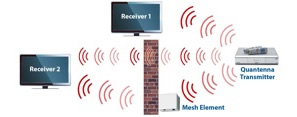Mesh networking is a key Full-11n™ ingredient for consistent and reliable 802.11n Wi-Fi wireless connectivity throughout the entire home. It is important because, even with optimal transmitter and receiver processing, average MIMO system throughput decreases with distance due to attenuation and path loss. Also, each home has its own unique propagation characteristics including thick walls or floors with large attenuation. As a result, it is difficult to ensure reliable high-speed coverage from a single Wi-Fi access point for a home of any given size, layout and construction.
Mesh networking works by placing one or more mesh elements at different locations in the home to route data from the access point to one or more receivers in hard-to-reach locations.

Mesh networking ensures consistent, reliable bandwidth throughout the home
4x4 MIMO systems with dynamic digital beamforming and MIMO receiver processing support high-rate, reliable connections between the transmitter and receivers at most locations in the home. However, there may be some locations blocked by a high-attenuation wall or reflector. The solution in these cases is to place a 4x4 mesh element at an intermediate location between the transmitter and the blocked receiver.
Mesh networking delivers other benefits, as well. First, it is scalable, so large houses or even office buildings can achieve almost 100 percent coverage simply by adding more mesh elements at strategic locations. Second, it is adaptive, meaning that mesh elements can change frequencies if necessary, or re-route through another element to maintain a reliable, high-speed link even if the end-to-end connection between a transmitter and receiver degrades due to intermittent interference. This is accomplished by changing frequencies of the mesh elements, or re-routing through another element.
